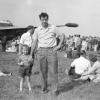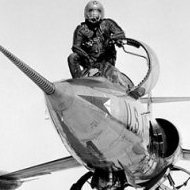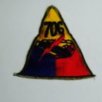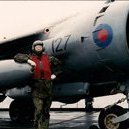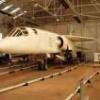Search the Community
Showing results for tags 'Bombs'.
-

ICM WWII German Aircraft Armament (48408) 1:48
Mike posted a topic in Aftermarket (updates/conversions)
WWII German Aircraft Armament (48408) 1:48 ICM via H G Hannants Ltd During WWII, numerous weapons systems (as we call them now) were developed by both Allied and Axis forces, standardised for mass manufacture, and for ease of interoperability between types of aircraft in use at the time. These were adapted and improved over time in light of operational experience, finishing the war with a much more potent arsenal than it started with. The Kit This new set from ICM arrives in a shallow top-opening box with a captive lid on the lower tray, and inside are six sprues of grey styrene, a square decal sheet, and two instruction sheets, as one of the sub-sets has been released previously a few years ago. The set contains the following armaments: 8 x SC 50Jb bomb 4 x SC 250Ja Bomb 4 x SC 500J 8 x SD 50Stg 4 x SD 250Jb 4 x SD 500A 2 x F5 Torpedo with trailer Each bomb, regardless of size is made from two halves, and they have two fins moulded-in along the seamline, the other two a separate part that slots into the tail perpendicular to the others. The SC 50 and SD 50s have four tubular “screamers” attached to the fins, which create a terrifying whistling noise on the way down, with the same installation seen as an option on the 250kg bombs too, if they aren’t using the inter-fin supports that stabilise the rear. The SC 500J has four fin supports added, while the SD 500A has a circular ring supporting the fins. The SD 50Stg bombs have “daisy cutter” extended fuses moulded-in, but the SD 250Jb has an adapter ring and fuse extension as an optional fitment. The F5 Torpedo was developed for the Luftwaffe by the Kriegsmarine from an earlier Norwegian design, adding a break-off wooden H-tail that helped ensure a smoother insertion into the water, which at a little under a tonne was an important stage in its flight envelope. It was carried by several German bombers such as the Ju.88 and He.111, the latter being able to carry a pair on a palette covering the bomb bay doors, and even the Fw.190 could be configured to carry one under its belly. Two sprues of grey styrene each contain parts for a single torpedo, plus a trailer to transport it around the airfield. The trailer is made first, with six cross-members installed on a cruciform chassis and fleshed out with a set of tubular frames and sections of tread-plate on either side of where the torpedo will sit. A pair of wheels glue to the short ends of the crucifix, then the torpedo is built from two halves with a double row of blades on the screw and a pair of perpendicular fins at the rear. The break-off tail is made from two T-shaped end panels, with four vanes stretched between them. The wooden tail slots over the torpedo’s fins, and the finished weapon is lowered into the cradle running along the trailer’s direction of travel. Markings A chart on the rear of the bomb instructions gives colour choices in ICM codes, and location of the many stencils that were applied to bombs by their handlers to tell the different types from one another in the armoury, and whether they contain explosives. The Torpedoes have their own drawings for painting, and unlike the bombs, they have no stencils applied. Decals are by ICM’s usual partners, which is a guarantee of good registration, sharpness and colour density, with a thin gloss carrier film cut close to the printed areas. Conclusion These well-detailed bombs and torpedoes are easy to build from a material we are all familiar with, and provide copious armaments for your WWII German projects without breaking the bank. Highly recommended. Available in the UK from importers H G Hannants Ltd. Review sample courtesy of -

ICM WWII British Aircraft Armament (48407) 1:48
Mike posted a topic in Aftermarket (updates/conversions)
WWII British Aircraft Armament (48407) 1:48 ICM via H G Hannants Ltd During WWII, numerous weapons systems (as we’d call them now) were developed to fight the Axis forces, standardised for mass manufacture, and for ease of interoperability between types of aircraft in use at the time. These were adapted and improved over time in light of operational experience, the Allies finishing the war with a much more potent arsenal than it started with. This set depicts some of these designs, and arrives in a small top-opening box with a captive flap on the lower tray. Inside are four sprues of grey styrene, a decal sheet, two instruction booklets and a pamphlet advertising the recently launched ICM range of acrylic paints that we’ve reviewed on this here forum. One sprue depicts the British 18” Mk.XII Torpedo that was an air-launched variant of the earlier Mk.XI, entering service in the early 30s. The Mark.12 was the variant used by the Fleet Air Arm and RAF Coastal Command during WWII, and could be fitted with a break-off wooden tail fairing to reduce entry speed into the water, and the nose was painted red for a training round, or the less visible black for a live round, which goes against the “red for danger” methodology normally used. It is the most complex assembly of the set and has its own booklet that details construction. The torpedo is made first, built from two halves with a double row of screws and a pair of perpendicular fins at the rear, two of which are moulded-in. The optional break-off tail is made from two rectangular end panels, with a single horizontal plane stretching between them. The wooden tail includes the tail fins of the torpedo and is a straight replacement to the standard fins, then a spacer and large spinner are fitted to the front. The guts of the trolley consists of two scissor jacks, and these are both made from four parts each that are mounted onto a slotted base, then surrounded by a framework with two small balancing wheels at either end. A short axle projects from the centre of the rails, and these mount a larger wheel with integrated tyre, plus a winder at each end that operates the scissor-jacks (on the real thing). The torpedo is lowered into the cradle along the trolley’s direction of travel to finish off. The other three sprues are identical, containing parts that allow you to make the following: 3 x 1,500lb Aerial Mine 6 x GP 250lb Bomb 6 x MC 250lb Bomb 6 x MC 500lb Bomb 6 x GP 500lb Bomb 6 x SAP 250lb Bomb 6 x Bomb Rack, combination of left & right wings, plus two bomb bay racks Each bomb is made from two halves, adding end caps and parachute bundle to the mine, additional fins and circular rings to the majority of the others, and a choice of sway-braces to the bomb racks, depending on which bombs you will be mounting. Markings The torpedo and trailer have no stencils, but the bombs have stencils and designation bands around them, which are curved on the sheet to ensure that they conform to the shape of the weapon they’re intended for. Decals are by ICM’s usual partners, which is a guarantee of good registration, sharpness and colour density, with a thin gloss carrier film cut close to the printed areas. Conclusion A useful set for anyone with a need for munitions for their latest British WWII project. There are a lot of them in the box, and despite their simple construction, they have plenty of detail moulded-in. Highly recommended. Available in the UK from importers H G Hannants Ltd. Review sample courtesy of -
Good evening, among the "not for use" parts in Eduards 1/72nd Fagot are a pair of bombs. I cannot find similar ones in my copy of Yefim Gordons "Soviet / Russian Aircraft Weapons Since WW2" - does anyone know what type of bomb these represent, and which aircraft / air forces used these? Thanks in advance!, Andre
-
Hi all, I’m in the closing stages of my Mustang build and had a potential change of thought last night regarding ordnance. My plan had been to install the WW2-style underwing tanks but I now realise that most, if not all, photos show these machines (Indonesian) with bombs and not tanks. My question is: what are these bombs and are they of the type used in the 1950s? To my untrained eye they look like they could be Japanese WW2 era. Any ideas, please? Thanks a lot. Martin
-
GBU-54 JDAM (MK 82) Bombs (USAF & USN) (209232 & 209132) 1:32 VideoAviation.com The GBU-54 or JDAM (Joint Direct Attack Munition) is a guidance kit which converts various dumb bombs ito GPS Guided Munitions, in this case the Mk.82 bomb. A further development is the Laser JDAM. This retains the accuracy of the GPS weapon with the ability to engage moving targets being lased by ground unit. The laser unit (DSU-38/B) communicates with the fuse in the tail with a fixed wire harness running along the bomb body. The Bombs They arrive in videoaviation's standard clear clam-shell box with an insert showing the bombs. The bombs are split into the main body and the tail for moulding reasons. The USN weapons have the ablative coating moulding on. There are small runs of bomb lugs, and GPS antennas. There is also a small sheet of decals for each set with different marking between the USN & USAF. USAF USN Conclusion Another quality product from Videoaviation. If you're planning on bombing up your 1/32 USN/USAF modern aircraft then you need to look at these. Highly recommended. USAF USN Review samples courtesy of
-
RAF 1000LB Bombs (Free fall & Retarded tails) (209432 & 209532) 1:32 VideoAviation.com The RAF Have used the 1000Lb bomb for a while, the standard bomb body can be fitted with a variety of Fuzes and tails, including paveway guided bomb kits. The Bombs They arrive in videoaviation's standard clear clam-shell box with an insert showing the bombs. Like the real bombs they are split into the bomb body and the tail units. There are a couple of resin runners which hold the tail fuse vanes and the carry lugs. There is also 2 small decal sheets for each set. Freefall Tails Retarded Tails Conclusion Another quality product from Videoaviation. If you're planning on bombing up your 1/32 RAF aircraft then you need to look at these. Highly recommended. Free Fall Retarded Review sample courtesy of
-
Just about to add the bomb to my Special Hobby Kittyhawk 1a but not sure what colour it would have been during this period, 41-42 western desert, so any clues please? Also would the fuse be a silver colour or painted the same as the bomb itself? Regards Colin.
-
I was looking at a review of the Orange Hobby F-35C kit the other day, and something about the kit left me wondering. The F-35C is the Navy version of the aircraft, so it has folding wings. The version of the kit in question allowed the plane to be modeled in "beast mode" with a full load of under wing ordnance. In "beast mode" the aircraft has three under wing pylons on each side, with the outboard pylon on the section of the wing that folds up. The manufacturer's pics of the assembled model showed the aircraft with the wings folded, and a Sidewinder missile mounted on the outboard pylon at the same time. Would this actually happen in normal carrier ops? I know nothing about the subject, but it just seemed... odd to have a live missile on the folded up wing like that. Thanks!
- 13 replies
-
- carrier flight ops
- bombs
-
(and 1 more)
Tagged with:
-
GBU-38 Non-Thermally Protected 1:72 Eduard The GBU-38 is a 500lb air-dropped weapon that is part of the JDAM (Joint Direct Attack Munition) family of GPS-guided bombs. The weapon is relatively modern and was deployed in combat in Afghanistan. In common with most other 1:72 scale brassin weapon sets, the set of four GBU-38s arrive packaged into the usual Eduard blister pack, complete with decals and a small fret of photo etched parts. Each bomb comprises the main body of the weapon with the ballistic tail cast in place, a choice of two heads are provided for both USN and USAF variants, both with optional protective caps. The casting is flawless and smooth, with minimal cleanup required thanks to the positioning of the pouring stubs at the tail-end of the weapon. Colours and stencil positions are marked in a colour diagram, with Gunze Mr Color paint references as usual. Review sample courtesy of
-
Ok so Im considering restarting work on my oldest shelf queen. Its an old Monogram PBY-5 non-amphib. I started in 2003. Im doing it in RAAF camouflage. Im doing a night harassement Catalina. Similar to the Black cats. I know the colors are RAAF night, RAAF Dk. Ocean blue, over Matt black. I equate the colors to EDSG, USN non spec. Sea blue, over Matt Black. I know Red Roo do a decal set for the plane Im doing, however Ive been waiting 3 years and can never seem to scrape the $ together. It would eat about 6 months budget up in one purchase. What i really am looking for and need is. 1) Roundel and code sizes in inches or CM’s ? Outer diameter ? Inner circle diameter ? I can convert these to 1/48th. So i can make masks. 2) Placement locations - all 6 or just upper wings and Fuselage ? 3) Roundel Colors ? Which Blue is best over the white ? 4) What kind of antennas besides the standard radio wires would they have carried ? Similar to USN or RN? Or completely different. Im not sure if i should use the search antennas included in the kit that mount under the wing ? Any help or info. someone can provide me moves this project closer to completion ? I did recieve info pertaining to the camouflage patterns, and colors about 9 months ago when i queried about that. Which went along way to moving this along. Thank you in advance. Dennis
-
Paveway II and Paveway III Laser Guided Bombs 1:32 CMK The Guided Bomb Unit-12 (GBU-12) utilizes a Mk82 500-pound general purpose warhead. The operator illuminates a target with a laser designator and then the weapon guides to a spot of laser energy reflected from the target. The GBU-12 is a member of the Paveway II series of laser guided bombs (LGBs). These weapons are hybrids. At the core of each is a bomb: a 500-pound Mk 82 for the GBU-12. A laser guidance kit is integrated with each bomb to add the requisite degree of precision. The kit consists of a computer control group at the front end of the weapon and an airfoil group at the back. When a target is illuminated by a laser - either airborne or ground-based - the guidance fins (canards) react to signals from the control group and steer the weapon to the target. Wings on the airfoil group add the lift and aerodynamic stability necessary for in-flight manoeuvring. The pack contains two well detailed and moulded resin bomb units, with the rear fins folded for carriage. There are separate forward fins and guidance heads which characteristically droop when on the ground and un-powered. A decal sheet is provided containing a full set of stencilling for both bombs and a sheet of pre painted photo etched remove before flight flags complete with attachment wire and rings. To only awkward part of the assembly would appear to be the removal of the moulding plug at the base of each bomb where care will need to be taken not to damage the rear fins. The seeker heads are also a bit awkward in that the cut line of the moulding block is indistinct, fortunately the paint guide should aid where the cut is to be made. The forward fins are much easier to remove and fit though. The painting guide shows the colours required for the bombs in service with different air arms, that of the US Navy, US Air Force and Luftwaffe. The Guided Bomb Unit-24 (GBU-24) Low Level Laser Guided Bomb [LLLGB] consists of either a 2,000-pound MK-84 general purpose or BLU-109 penetrator bomb modified with a Paveway III low-level laser-guided bomb kit to add the proportional guidance in place of the bang-bang type used in the Paveway II. The LLLGB was developed in response to Sophisticated enemy air defences, poor visibility, and to counter limitations in low ceilings. The weapon is designed for low altitude delivery and with a capability for improved standoff ranges to reduce exposure. The GBU-24 LLLGB/Paveway III has low-level, standoff capability of more than 10 nautical miles. Performance envelopes for all modes of delivery are improved because the larger wings of the GBU-24 increases manoeuvrability. Paveway III also has increased seeker sensitivity and a larger field of regard. This bomb is not nearly as delivery parameter sensitive as is the Paveway II LGB, nor is it affected by early laser designation. After a proper low altitude delivery, the LLLGB will maintain level flight while looking for reflected laser energy. If it does not detect reflected laser energy, it will maintain level flight to continue beyond the designated target, overflying friendly positions, to impact long, rather than short of the target. In 1996 the Navy conducted tests of the F-14A Tomcat with the GBU-24B/B Hard Target Penetrator Laser-Guided Bomb at Naval Air Station Patuxent River, Md., as part of an air-to-ground development program to support clearance for use of the weapon in the fleet by F-14 Tomcats. As with the Paveway II pack this set contains two bombs although these are appreciably larger, naturally as the core is that of a 2000lb bomb. Each weapon is made up of the body, separate tail unit which doesnt look as awkward to remove the moulding block as it is attached to the forward edge rather than the rear so the guidance fins are unaffected, the forward fins, which will need some careful removal from their moulding blocks and clear resin seeker heads. Once again the detail is really well done although I imagine the bomb lugs will need to be removed if fitting to an aircraft pylon. The included decal sheet includes all the stencils required depending on which service they are in use with and the colour painting guide shows which go where as well the correct colours for use with the US Navy, US Air Force and RAF. TO finish them off the set also has a sheet of pre-painted photo etched remove before flight tags. Conclusion Both of these sets of bombs are really well designed and will provide quite a visual impact to any model they are fitted to. Alternatively they can be used as part of a diorama on a trolley or bomb sled that are available from other manufacturers. There are also quite a few 1:32 aircraft that they can be used with so Id imagine that youd need more than just one set. Very highly recommended. Review samples courtesy of
-
Back in the 70's & 80's the Modern aircraft kits always had a selection of GP Bombs and Cluster Bombs to load up your completed models. The tendency these days is for smart bombs and missiles which is fine, but I find it odd that apart from the Canberra B-8, the rest of the cold war RAF types from Buccaneer to Harrier GR3 have only had SNEB as their conventional load, no new 1000 lb GP bombs, no new BL755 cluster bombs. Now I know Cluster Bombs are no longer politically acceptable, but it does seem odd that they appear to be avoiding them, along with the traditional 1000 lb'ers.
- 56 replies
-
- Cold War ordanance
- Bombs
-
(and 2 more)
Tagged with:
-
Hello, first post here but long time lurker. It's bad form to introduce oneself with a question but I suppose it's inevitable. I'm looking for photographic reference for the tubular bomb carrier in this drawing. It is quite distinct from the Universal bomb carriers which seemed to come into action in the late 20s. This would have been in use post WWI upto the late 20s. I've also been unnsuccessful finding bombs that match the appearance of these drawn in this Supermarine drawing. I'm more likely to replace these with more common bombs I've found in museums (Hendon etc) as I imagine they might be more sketchy. It looks very similar to these carriers on the prototype Southampton and the Vickers Vilderbeest. Thanks for any help. I hope I don't have to make too much up!
- 9 replies
-
- bombs
- bomb rails
-
(and 2 more)
Tagged with:




